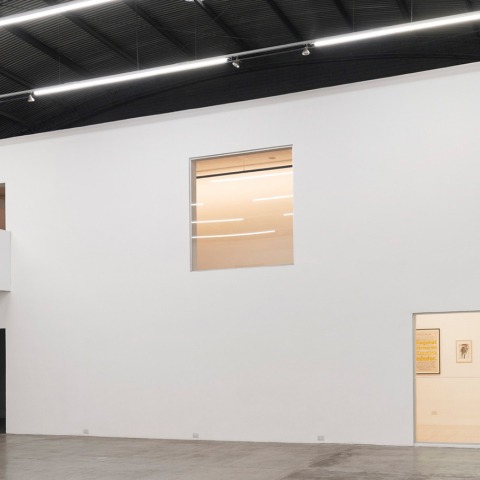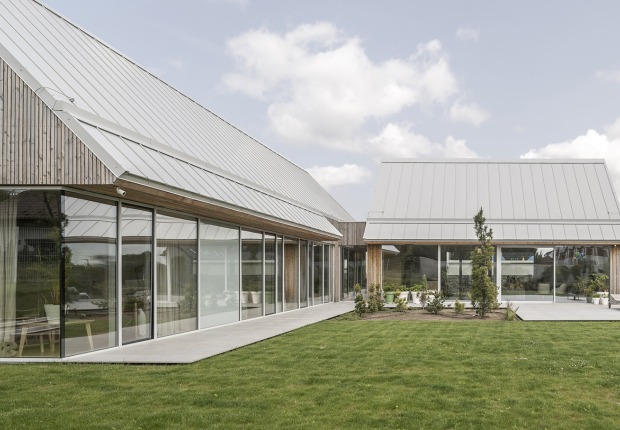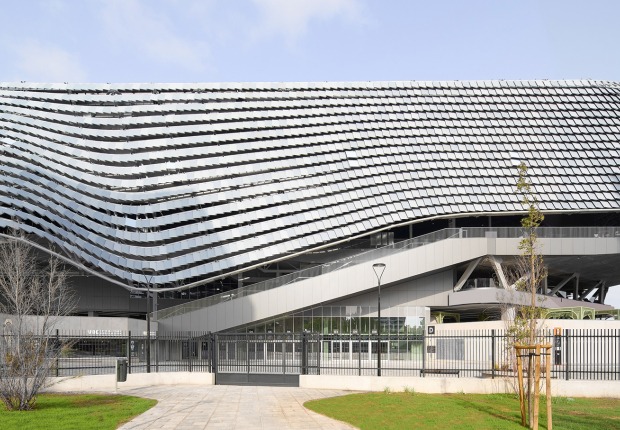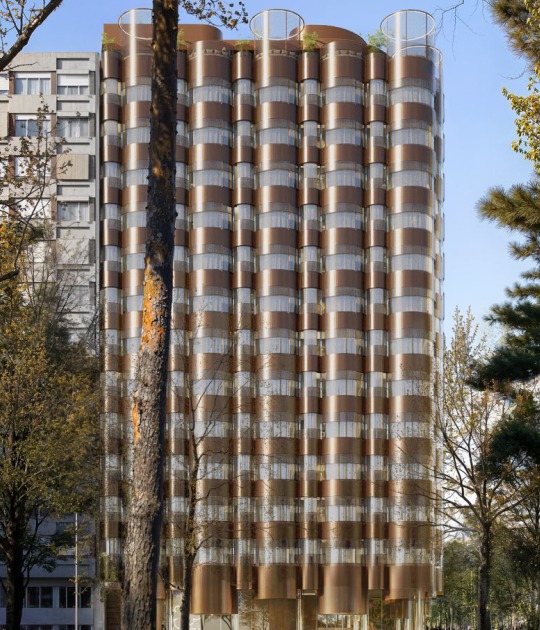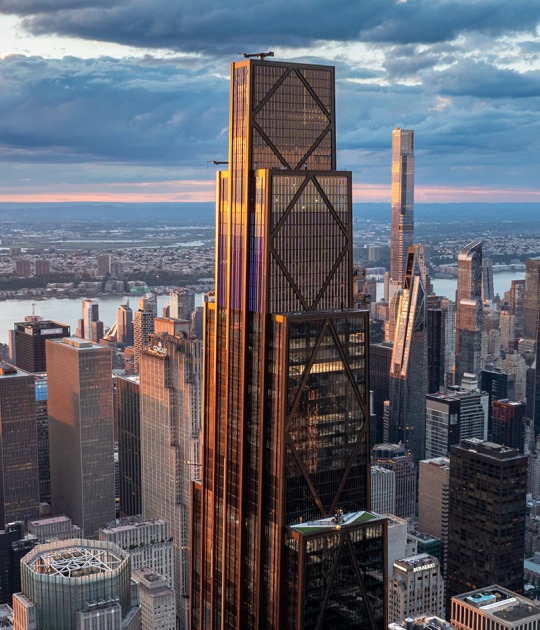Project description by Ben-Avid + MMBB Arquitetos
Una pregunta
La sede central de la fundación El Gran Vidrio cuenta con un restaurante y un espacio de producción, discusión, exposición y venta de arte contemporáneo. El proyecto de reforma de la galería suponía en primer lugar preguntarse si era necesario introducir modificaciones en un espacio que de antemano se nos ofrecía extraordinario. Una planta rectangular de 18 x 14 m., sin pilares intermedios, cubierta por una estructura metálica, definía una sala de exposiciones de gran altura que no ocultaba las reminiscencias de un antiguo galpón de estacionamiento. La intervención de la sala, que en los últimos años había ganado un lugar de destaque en la escena de la producción y difusión cultural de la ciudad, procuraría entonces apenas reforzar sus atributos espaciales, mejorar su infraestructura técnica y habilitar nuevos recorridos y alternativas de montaje para artistas y comisarios.
Un encargo
El objeto inicial del proyecto consistía en transformar un estrecho depósito ubicado sobre la trastienda en una sala de eventos y expansión del restaurante. Dado que acceder a ese espacio desde el ingreso principal suponia atravesar la galeria, ideamos una pasarala metalica que sobrevuela el espacio expositivo, conectando de forma aérea el restaurante con el nuevo salón de eventos.
Una pieza
Dos vigas reticuladas vencen catorce metros de luz, al tiempo que resuelven la varanda de la pasarela, revestida exteriormente con chapa blanca para minimizar su impacto visual en la sala.
Una escalera conformada por piezas de hormigon pre-moldeado se implanta en el lugar de un pequeño deposito de la cocina, dando acceso a una planta alta que cuenta con dos alas paralelas conectadas por la pasarela. En un extremo, un futuro estudio para residentes de la fundación; en el otro, una sala alargada, equipada con un área de apoyo de cocina, pensada para funcionar como expansión del restaurante, como espacio para eventos sociales, o también como espacio expositivo; entre ambos, el gran vacío central de la sala, encuadrado por un pequeño conjunto de aberturas fijas. De esta manera, la pasarela permite que los nuevos programas funcionen con independencia de la galería, y, al mismo tiempo, inaugura vistas y recorridos aereos de la sala de exposiciones, habilitando nuevas posibilidades de montaje en el gran volúmen de la sala.
Una serie de pequeñas cosas
El resto del proyecto consiste en un conjunto mejorías de la sala de exposiciones. En primer lugar, se unifican las superficies de piso de ambas plantas, removiendo la pintura epóxica del piso del antiguo estacionamiento, a través de un proceso de pulido que desnuda un conjunto de hormigonados de color y grano diverso.
En segundo lugar, una nueva planta de luces permite tanto una iluminación homogénea como puntual de la sala, a partir de un sistema de rieles electrificados suspendidos a seis metros de altura. Alineado con con el borde superior de las paredes, este sistema produce un destaque de los planos de colgado en relación a la estructura metálica existente.
Por ultimo, ubicadas sobre las paredes cortas de la sala, dos paredes dobles resuelven las infraestructuras pluviales y eléctricas, y el cerramiento de las aberturas sobre la calle, ganando así amplias superficies de colgado. Sobre la pared de mamposteria portante se remueven columnas innecesarias y se reduce sustancialmente las areas vidriadas de la trastienda. Con estas operaciones, los cuatro planos de cerramiento vertical de la sala se liberan de interferencias, pasando a ofrecer mas de 350 m² de paredes continuas para el montaje de obras.
---
A question
The headquarters of the El Gran Vidrio Foundation has a restaurant and a space for production, discussion, exhibition and sale of contemporary art. The gallery reform project involved first of all wondering if it was necessary to introduce modifications in a space that was previously offered extraordinary. An 18 x 14 m rectangular plant, without intermediate pillars, covered by a metal structure, defined a high-rise exhibition hall that did not hide the reminiscences of an old parking lot. The intervention of the room, which in recent years had gained a place of prominence in the scene of cultural production and dissemination of the city, would then try to barely reinforce its spatial attributes, improve its technical infrastructure and enable new routes and assembly alternatives For artists and curators.
A commission
The initial purpose of the project was to transform a narrow warehouse located on the back room into an event room and restaurant expansion. Since accessing that space from the main entrance meant going through the gallery, we devised a metal walkway that flies over the exhibition space, connecting the restaurant with the new event hall.
One piece
Two reticulated beams overcome fourteen meters of light, while solving the catwalk of the catwalk, coated externally with white sheet to minimize its visual impact on the room.
A staircase made up of pre-molded concrete pieces is implanted in the place of a small kitchen warehouse, giving access to a high floor that has two parallel wings connected by the gangway. At one extreme, a future study for residents of the foundation; in the other, an elongated room, equipped with a kitchen support area, designed to function as an expansion of the restaurant, as a space for social events, or also as an exhibition space; between them, the great central vacuum of the room, framed by a small set of fixed openings. In this way, the catwalk allows the new programs to work independently of the gallery, and, at the same time, opens views and air routes of the exhibition hall, enabling new possibilities for assembly in the great volume of the room.
A series of little things
The rest of the project consists of a set of improvements to the exhibition hall. First, the floor surfaces of both floors are unified, removing the epoxy paint from the floor of the old parking lot, through a polishing process that strips a set of concretes of color and diverse grain.
Secondly, a new light plant allows both homogeneous and timely lighting of the room, based on a system of electrified rails suspended at six meters high. Aligned with the upper edge of the walls, this system produces a highlight of the hanging planes in relation to the existing metal structure.
Finally, located on the short walls of the room, two double walls solve the pluvial and electrical infrastructures, and the closing of the openings on the street, thus gaining large hanging surfaces. Unnecessary columns are removed on the supporting masonry wall and the glazed areas of the back room are substantially reduced. With these operations, the four vertical enclosure plans of the room are free of interference, offering more than 350 m² of continuous walls for the assembly of works.
El Gran Vidrio is a gallery placed in Cordoba city, Argentina, which in recent years has been gaining prestige in the scene of the production and cultural diffusion of the city. Ben-Avid + MMBB Arquitetos were commisioned to designed the renovation.
Ben-Avid + MMBB Arquitetos propose a renovation project on the gallery with a minimal intervention in which only its spatial attributes are reinforced, its facilities are improved and new routes and mounting alternatives for artists and curators are possible.
More information
Published on:
November 28, 2019
Cite:
"El Gran Vidrio gallery renovation by Ben-Avid + MMBB Arquitetos " METALOCUS.
Accessed
<https://www.metalocus.es/en/news/el-gran-vidrio-gallery-renovation-ben-avid-mmbb-arquitetos>
ISSN 1139-6415
Loading content ...
Loading content ...
Loading content ...
Loading content ...
Loading content ...
Loading content ...
Loading content ...
Loading content ...
Loading content ...
Loading content ...
Loading content ...
Loading content ...
Loading content ...
Loading content ...
Loading content ...
Loading content ...
Loading content ...
Loading content ...
Loading content ...
Loading content ...
Loading content ...
Loading content ...
Loading content ...
Loading content ...
Loading content ...
Loading content ...
Loading content ...
Loading content ...
Loading content ...
Loading content ...
Loading content ...
Loading content ...
Loading content ...
Loading content ...
Loading content ...
Loading content ...
Loading content ...
Loading content ...
Loading content ...
Loading content ...
Loading content ...
Loading content ...
Loading content ...
Loading content ...
Loading content ...
Loading content ...
Loading content ...
Loading content ...
Loading content ...
Loading content ...
Loading content ...
Loading content ...
Loading content ...
Loading content ...
